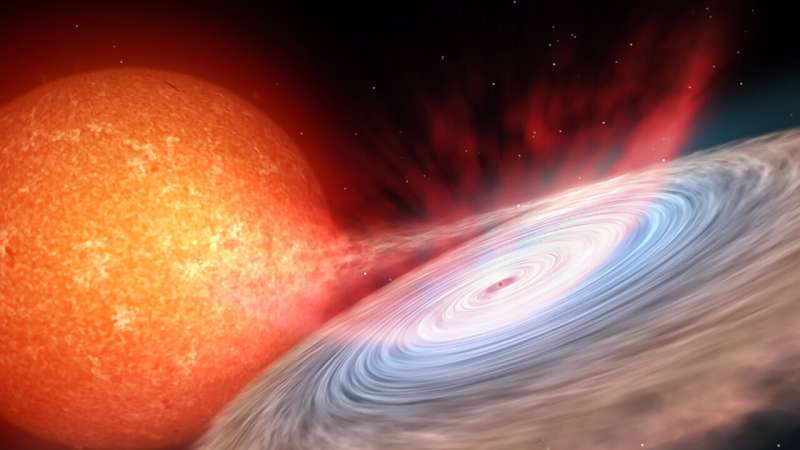Artistic impression of the constant emission of winds produced during the eruption of a black hole in an X-ray binary. Credit: Gabriel Pérez Díaz, SMM (IAC).
A team of researchers from the Instituto de Astrofísica de Canarias (IAC) has, for the first time, detected constant infrared emission from winds produced during the eruption of a black hole in an X-ray binary.
Until now, these flows of material had been detected only in other wavelength ranges, such as X-rays or within the visible spectrum, depending on the phase in which the black hole consumes its surrounding material. This study provides the first evidence that the winds are present throughout the evolution of the eruption, independently of the phase, representing a step forward in the understanding of the mysterious processes of accretion onto stellar-mass black holes. The article has just been published in Astronomy and Astrophysics.
X-ray binaries, as their name implies, are binary stars that emit strong radiation in X-rays. They are formed by a compact object, normally a black hole, with a stellar companion. Low-mass X-ray binaries (LMXB) have companions with masses equal to, or less than the mass of the sun. In these systems the two stars orbit at a distance so small that some of the mass of the star falls into the gravitational well of the black hole, forming a flat disc of material around it. This process is called accretion, and the disc is an accretion disc.
Transitory X-ray binaries are those in which the amount of mass accreting onto the black hole is initially small and its brightness is too low to detect from the Earth, but which transition to eruptive states in which the black hole's accretion rate increases and the material in the disc heats up, reaching values between 1 million and 10 million degrees Kelvin. During these eruptions, which can last from weeks to several months, the system emits a large flux of X-rays, and its brightness increases by several magnitudes.
Astronomers still don't know the exact physical processes that occur during these accretion episodes. "These systems are places where matter is subjected to gravitational fields that are among the strongest in the universe, so that X-ray binaries are physics laboratories that nature provides us for the study of compact objects and the behavior of the matter surrounding them," explains Javier Sánchez Sierras, a predoctoral researcher at the IAC and the first author of the article.
One of the most important physical processes scientists need to understand is the winds of material ejected during accretion episodes. Teo Muñoz Darias, an IAC research and coauthor of the article, says, "The study of winds in those systems is a key to understand accretion processes, because the winds can expel even more matter than is accreted by the black hole."
Same wind, different states
The article presents the discovery of winds from the black hole MAXI J1820+070 in the infrared range during an eruption that took place during 2018-2019. In the past two decades, winds have been observed in X-rays during so-called "soft" eruptions in which the radiation emitted by the accretion disc is dominant, showing high luminosity. More recently, the same group at the IAC has discovered winds at visible wavelengths in the hard state of accretion, which are characterized by the appearance of a jet that is essentially perpendicular to the accretion disc, and which emits strongly at radio wavelengths.
Sánchez Sierras says, "In the present study, we have shown the discovery of infrared winds that are present during both the hard and soft accretion states during the full evolution of the eruption, so that their presence does not depend on the accretion state. This is the first time that this type of wind has been observed." The researchers have also demonstrated that the kinematic properties of the wind are similar to those observed in 2019 in the visible range, reaching velocities of up to 1800 km/s.
"These data suggest that the wind is the same for both cases, but its visibility changes wavelength during the evolution of the eruption, which would indicate that the system is losing mass and angular momentum during the process of the eruption," explains Muñoz Darias. These results are significant because they add a new element to the global picture of the winds in these systems, and represent a step toward the goal of a complete understanding of the processes of accretion onto stellar-mass black holes.
More information: J. Sánchez-Sierras et al, Near-infrared emission lines trace the state-independent accretion disc wind of the black hole transient MAXI J1820+070, Astronomy & Astrophysics (2020). DOI: 10.1051/0004-6361/202038406
Journal information: Astronomy & Astrophysics
Provided by Instituto de Astrofísica de Canarias
























